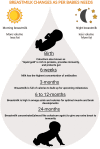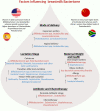Breast Milk: A Meal Worth Having
- PMID: 35155521
- PMCID: PMC8826470
- DOI: 10.3389/fnut.2021.800927
Breast Milk: A Meal Worth Having
Abstract
A mother is gifted with breast milk, the natural source of nutrition for her infant. In addition to the wealth of macro and micro-nutrients, human milk also contains many microorganisms, few of which originate from the mother, while others are acquired from the mouth of the infant and the surroundings. Among these microbes, the most commonly residing bacteria are Staphylococci, Streptococci, Lactobacilli and Bifidobacteria. These microorganisms initiate and help the development of the milk microbiota as well as the microbiota of the gastrointestinal tract in infants, and contribute to developing immune regulatory factors such as cytokines, growth factors, lactoferrin among others. These factors play an important role in reducing the risk of developing chronic diseases like type 2 diabetes, asthma and others later in life. In this review, we will summarize the known benefits of breastfeeding and highlight the role of the breast milk microbiota and its cross-talk with the immune system in breastfed babies during the early years of life.
Keywords: breastfeeding; chronic diseases; delivery; immune system; microbiota.
Copyright © 2022 Duale, Singh and Al Khodor.
Conflict of interest statement
The authors declare that the research was conducted in the absence of any commercial or financial relationships that could be construed as a potential conflict of interest.
Figures





References
-
- Guo M. Human Milk Biochemistry and Infant Formula Manufacturing Technology. 1st ed: Woodhead Publishing. (2014). 10.1533/9780857099150.1 - DOI
Publication types
LinkOut - more resources
Full Text Sources

